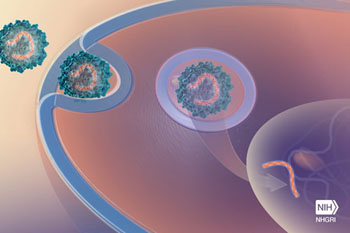Gene Therapy Increases Lifespan of Mice with Niemann-Pick Disease
By LabMedica International staff writers
Posted on 09 Nov 2016
The potential for treating Niemann-Pick Disease Type C1 with gene therapy was demonstrated in a mouse model of the syndrome.Posted on 09 Nov 2016
Niemann-Pick disease, type C1 (NPC1) is a heritable lysosomal storage disease characterized by a progressive neurological degeneration that causes disability and premature death. Approximately 95% of Niemann–Pick type C cases are caused by genetic mutations in the NPC1 gene, referred to as type C1. The NPC1 gene encodes a protein that is located in membranes inside the cell and is involved in the movement of cholesterol and lipids within cells. A deficiency of this protein leads to the abnormal buildup of lipids and cholesterol within cell membranes.

Image: The gene therapy involved inserting a functional copy of the NPC1 gene into mice with the disease; the treated animals were then found to have less severe NPC1 symptoms (Photo courtesy of Darryl Leja, National Institutes of Health/National Genome Research Institute).
Investigators at the [U.S.] National Institutes of Health/National Genome Research Institute (Bethesda, MD, USA) worked with the Npc1-/- mouse model of NPC1 disease. These animals display a rapidly progressing form of NPC1 disease, which is characterized by weight loss, ataxia, increased cholesterol storage, loss of cerebellar Purkinje neurons, and early lethality. To test the potential efficacy of gene therapy for NPC1, the investigators constructed adeno-associated virus serotype 9 (AAV9) vectors to deliver the NPC1 gene.
Results published in the October 26, 2016, online edition of the journal Human Molecular Genetics revealed that the Npc1-/- mice that received a single dose of AAV9-CamKII-NPC1 as neonates or at weaning, and the mice that received a single dose of AAV9-EF1a-NPC1 at weaning, exhibited an increased life span, characterized by delayed weight loss and diminished motor decline. Cholesterol storage and Purkinje neuron loss were also reduced in the central nervous system of AAV9 treated Npc1-/- mice.
"Our work in NPC1 mice may help lead to human clinical trials and eventually FDA approval for gene therapy as a treatment for NPC1 disease," said senior author Dr. Charles P. Venditti, an investigator at the National Genome Research Institute. "For NPC1 patients, gene therapy could halt progression of the disease, improve the quality of their lives and, hopefully, increase the patient's life span."
Related Links:
[U.S.] National Institutes of Health/National Genome Research Institute













